

Washington University in St. Louis. Teaching Tips - The Learning & Teaching Office. Twelve Active Learning Strategies. Example 1 Example 1 Explanation In order for students to learn effectively, they must make connections between what they already know (prior knowledge) and new content to which they're exposed.
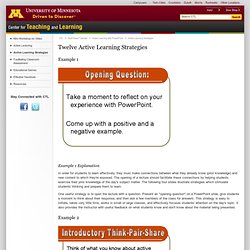
The opening of a lecture should facilitate these connections by helping students exercise their prior knowledge of the day's subject matter. The following four slides illustrate strategies which stimulate students' thinking and prepare them to learn. One useful strategy is to open the lecture with a question. Example 2 Example 2 Explanation. Interactive Lectures. Created by Heather Macdonald College of William and Mary and Rebecca Teed, SERC and updated by Gail Hoyt, University of Kentucky, Jennifer Imazeki, San Diego State University, Barbara Millis University of Texas, San Antonio, and Jose Vazquez-Cognet University of Illinois at Urbana-Champaign.
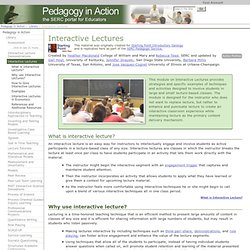
This module on Interactive Lectures provides strategies and specific examples of techniques and activities designed to involve students in large and small lecture-based classes. The module is designed for the instructor who does not want to replace lecture, but rather to enhance and punctuate lecture to create an interactive classroom experience while maintaining lecture as the primary content delivery mechanism. Interactive Lecture Demonstrations. Created by Dorothy Merritts, Robert Walter (Franklin & Marshall College), Bob MacKay (Clark College).
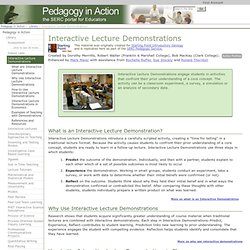
Enhanced by Mark Maier with assistance from Rochelle Ruffer, Sue Stockly and Ronald Thornton Interactive Lecture Demonstrations engage students in activities that confront their prior understanding of a core concept. The activity can be a classroom experiment, a survey, a simulation or an analysis of secondary data. What is an Interactive Lecture Demonstration? Interactive Lecture Demonstrations introduce a carefully scripted activity, creating a "time for telling" in a traditional lecture format. Predict the outcome of the demonstration. Think-Pair-Share. Think-Pair-Share activities pose a question to students that they must consider alone and then discuss with a neighbor before settling on a final answer.
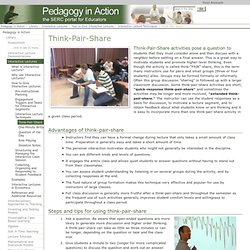
This is a great way to motivate students and promote higher-level thinking. Even though the activity is called think-"PAIR"-share, this is the term many instructors use for pairs and small groups (three or four students) alike. Groups may be formed formally or informally. Often this group discussion "sharing" is followed up with a larger classroom discussion. Some think-pair-share activities are short, "quick-response think-pair-share" and sometimes the activities may be longer and more involved, "extended think-pair-share. " Advantages of think-pair-share Instructors find they can have a format change during lecture that only takes a small amount of class time. Active Learning For The College Classroom. The past decade has seen an explosion of interest among college faculty in the teaching methods variously grouped under the terms 'active learning' and 'cooperative learning'.
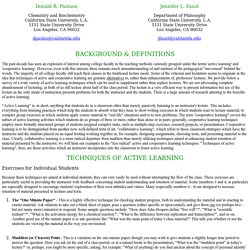
However, even with this interest, there remains much misunderstanding of and mistrust of the pedagogical "movement" behind the words. The majority of all college faculty still teach their classes in the traditional lecture mode. Some of the criticism and hesitation seems to originate in the idea that techniques of active and cooperative learning are genuine alternatives to, rather than enhancements of, professors' lectures. We provide below a survey of a wide variety of active learning techniques which can be used to supplement rather than replace lectures. We are not advocating complete abandonment of lecturing, as both of us still lecture about half of the class period. "Active Learning" is, in short, anything that students do in a classroom other than merely passively listening to an instructor's lecture. Jigsaws. Developed by Barbara Tewksbury, Hamilton College "When efforts are structured cooperatively, there is considerable evidence that students will exert more effort to achieve - learn more, use higher-level reasoning strategies more frequently, build more complete and complex conceptual structures, and retain information learned more accurately" (Johnson and Johnson, 1999, Making Cooperative Learning Work).
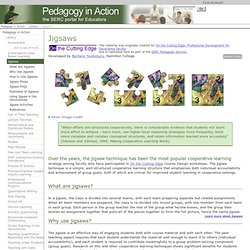
Over the years, the jigsaw technique has been the most popular cooperative learning strategy among faculty who have participated in On the Cutting Edge Course Design workshops. The jigsaw technique is a simple, well-structured cooperative learning structure that emphasizes both individual accountability and achievement of group goals, both of which are critical for improved student learning in cooperative settings. What are jigsaws? In a jigsaw, the class is divided into several teams, with each team preparing separate but related assignments.